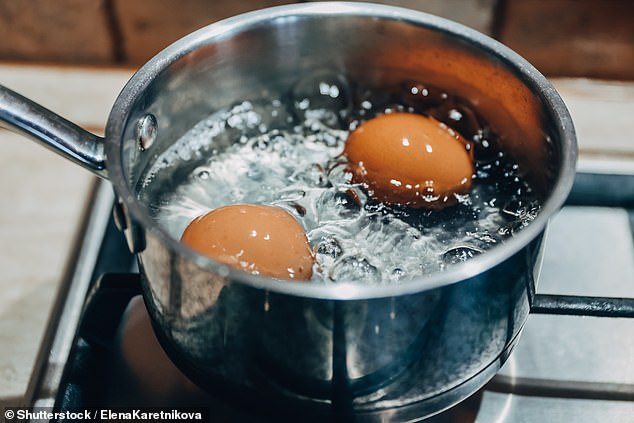- Dapatkan link
- X
- Aplikasi Lainnya
- EXPLORE FURTHER: Bizarre and delightful methods folks use to spice up their cuppa-tea
It is among the simplest tasks you can perform in the kitchen.
However, it appears you have likely been boiling your eggs incorrectly all along.
Scientists have worked out the best way to boil an egg evenly so the yolk is beautifully creamy and the egg white is not too watery.
The only bad news, for those used to a quick six-minute soft-boiled egg, is that the new method takes over half an hour.
Material engineers in Italy went through 300 eggs attempting to discover the ideal method for boiling one with perfect texture, flavor, and nutritional value.
They were comparing a hard-boiled egg, a soft-boiled egg, the 'sous vide' version beloved of fancy restaurants, and a completely new technique.
This method involves alternately submerging an egg eight times between a pot of boiling water and a bowl of cold water, reportedly attaining the ideal result as per culinary professionals.
This solves the issue of having a yolky center that’s just right while the egg whites remain uncooked, which often occurs with eggs boiled inside their shells.

Scientists successfully heated the egg whites to an ideal temperature of 85°C, and the yolks were brought close to perfection at around 65°C.
The trick lies in constantly taking the egg out of the boiling water and submerging it in cold water, which prevents the yolk from turning hard and firm, while ensuring the egg whites slowly cook just enough to provide some texture.
Professor Ernesto Di Maio, senior author of the study from the University of Naples Federico II, whose usual work involves plastics, came up with the 'periodic cooking' technique and made all 300 eggs at home in his kitchen.
He said: 'I thought the techniques we use in materials science could produce the perfect egg, and the result really is exquisite.
'I have converted 50 of my family and friends to preferring eggs made this way, and they were served up with lemon and pepper at our laboratory Christmas party.
It might take approximately 32 minutes to prepare this particular egg dish, and I realize that many individuals may not have the luxury of time. However, I genuinely believe it’s worthwhile for those dear to us, instead of serving them incorrectly cooked eggs.
The research aimed to enhance 'sous vide' eggs, which are cooked for a minimum of one hour at consistently low temperatures, usually ranging from 60°C to 70°C, resulting in yolks with a smooth consistency.
According to Professor Di Maio, the problem lies in the fact that the egg whites are not cooked enough; they appear translucent and remain overly liquid.

The group he was heading, under the leadership of a researcher who turned out to dislike eggs, utilized advanced mathematical modeling techniques to determine the optimal method for cooking them.
They subsequently experimented with these methods, employing three different approaches involving directing light beams at eggs to assess both their level of doneness and nutritional content.
In the meantime, eight skilled tasters evaluated hard-boiled, soft-boiled, sous-vide, and intermittently cooked eggs, assessing attributes such as color, melty quality, and softness.
The findings published in the journal Communications Engineering revealed that an egg prepared with the periodic method exhibited a yolk that was both sweeter and saltier compared to one that was softly boiled.
The consistency of the yolk resembled that of a sous vide egg, yet the egg white was noticeably firmer, less moist, and more opaque.
Its texture was midway between a sous vide egg and a softly boiled one.
Professor Di Maio stated: "This egg spreads more easily on toast compared to a sous vide egg, which tends to soak into the bread."
However, it is still not appropriate to serve it in an eggcup and eat it with toast soldiers, as this would necessitate a softly boiled egg.
The novel method proved superior in enhancing the nutritional value of eggs compared to the other three techniques, though researchers indicate that additional studies are necessary to uncover the underlying cause.
Temperatures in the periodically-cooked egg white ranged between 35°C and 100°C during cooking, while the yolk hit a temperature of 67°C and stayed there.
Read more
Komentar
Posting Komentar